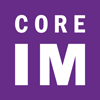Core IM
Join the hosts as they offer guidance on the diagnostic evaluation and initial management of hyperkalemia in CKD including guidelines for outpatient referrals in urgent management. In this episode of Core IM, the team will discuss this scenario and pearls that will lead to clinical practice improvement for a better understanding of Hyperkalemia in CKD.
First, listen to the podcast. After listening, ACP members can take the CME/MOC quiz for free.
CME/MOC:
Up to 1
AMA PRA Category 1 Credits ™ and MOC Points
Expires November 17, 2024
active
Cost:
Free to Members
Format:
Podcasts and Audio Content
Product:
Core IM
Welcome to Core IM, a virtual medical community! Core IM strives to empower its colleagues of all levels and backgrounds with clinically applicable information as well as inspire curiosity and critical thinking. Core IM promotes its mission through podcasts and other multimodal dialogues. ACP has teamed up with Core IM to offer continuing medical education, available exclusively to ACP members by completing the CME/MOC quiz.

1. Referral for urgent management of hyperkalemia
- Current guidelines suggest that the following outpatients should be referred for urgent management
- K+ > 6.0 mEq/L with OR without ECG changes
- Anyone with hyperkalemia and documented EKG changes
- However, there is no consensus on these recommendations and many clinicians manage hyperkalemia in the outpatient setting differently (especially with hyperkalemia < 6.0 mEq/L)
2. Hyperkalemia and ECG changes
- A retrospective chart review of about 90 patients admitted with severe hyperkalemia (K+ > 6 mEq/L (most patients had K+ < 7.2 mEq/L), who also received an ECG.
- Only 52% had ECG changes.
- Study authors could not identify a threshold at which you would see an EKG change.
- Recent retrospective study from 2019 compared ECG findings of 3 cohorts - K+ < 5.1 mEq/L (normokalemia), K+ between 6 and 7 mEq/L (moderate hyperkalemia), and K+ > 7.0 mEq/L (severe hyperkalemia)
- No significant difference in the frequency of ECG changes were found between the normokalemia and moderate hyperkalemia group
- More than half of all the hyperkalemic patients, including severe hyperkalemia, did NOT have any ECG changes.
Take-home point: ECGs are not sensitive at all in the detection of hyperkalemia. The absence OR presence of EKG changes does not predict the presence of hyperkalemia.
- Case report from Japan presents a patient with an initial K+ of 8.5 mEq/L and a normal ECG
- Returned <1 week later with recurrent K+ to 8.6 mEq/L.
- ECG now shows a sine wave pattern
- No consensus or solid data on what “chronic” hyperkalemia means, with respect to how high or how long a patient needs to have it
Take-home point: The abrupt change from normokalemia to severe hyperkalemia, not necessarily the K+ level itself, is most worrisome and needs to be treated.
3. Pseudo-hyperkalemia
- Conditions that lead to pseudo-hyperkalemia, the in vitro release of intracellular K+
- Excessive tourniquet use
- Fist clenching
- Vein trauma from multiple phlebotomy attempts
- PICC/central line draws
- Use of serum separator tube (clot activators) - commonly used to measure the “basic metabolic panel”
- Sending a whole blood sample, sent to the lab in an anticoagulated tube, is the most reliable way to get an accurate potassium reading
4. K+ restricted diets
- Taking a detailed dietary history helps guide management
- Common high K+ foods (“restriction” = < 2 g per day)
- Fruits - oranges, mangoes, avocadoes, melon, prunes, raisins, dates
- All types of potatoes, including yuca and yams
- Common side dishes, sauces, and snacks - tomatoes and tomato sauce, spinach, beans, lentils
- Salt substitutes often contain potassium chloride (KCl)
- Pro-tips for avoid complete K+ elimination from the diet include:
- Focus on moderation and portion size rather complete elimination
- Leach K+ from potatoes
- Drain liquids from cooked fruits, vegetables, and meats
- Common high K+ foods (“restriction” = < 2 g per day)
- High K+ diets have been linked to better blood pressure control and improved cardiovascular mortality in patients with hypertension.
- K+-rich diets also have high amounts of alkali, which counteract the metabolic acidosis of CKD
- Metabolic acidosis both worsens hyperkalemia AND contributes to the progression of CKD and higher mortality
- K+-rich diets also have high amounts of alkali, which counteract the metabolic acidosis of CKD
Low K+ diet results in increased Na+ reabsorption, and worsening blood pressure control
Take-home point: Complete elimination of K+ from the diet is not advisable. High K+ foods should be consumed in moderation, as they provide significant cardiovascular health benefits, especially for those with CKD.
5. Key medications that can cause hyperkalemia
- RAASi improve mortality, but are often the first medications to be discontinued when hyperkalemia is detected
- Difficult to predict how much the K+ will improve with stopping a RAASi
- Opposing driving forces for each individual’s potassium balance
- Diabetes and lower baseline estimated GFR have higher propensity for high K+
- Lack of insulin OR increased insulin resistance lead to a less robust insulin surge with meals (and less intracellular potassium shift)
- Common etiology of hyporeninemic hypoaldosteronism
- Diabetes and lower baseline estimated GFR have higher propensity for high K+
- Opposing driving forces for each individual’s potassium balance
NSAIDS and antibiotics are common medication offenders in hyperkalemia
- NSAIDs (and beta blockers) decrease renin release (and less RAAS activation), with decreased K+ excretion
- Antibiotics - the TMP component of TMP-SMX blocks potassium excretion in the collecting duct of the nephron
6. Treating outpatient hyperkalemia
- Sodium polystyrene sulfonate (SPS, a.k.a Kayexalate)
- Most of the data on SPS is retrospective, without any RCTs
- Retrospective cohort study of 1.8 million patients over age 66
- SPS users had 2x higher rates of GI events vs. controls
- GI events = intestinal ischemia, thrombosis, ulceration, perforation, resection, or ostomy creation
- Adverse effects more common with pre-existing or active GI conditions
- Most patients find SPS difficult to drink, as it tastes disgusting
- Patiromer
- Sodium zirconium cyclosilicate, SZC
- Influential trials include HARMONIZE and ENERGIZE.
- The NEJM study in 2015 showed that 1 dose of SZC has a rapid onset, with normokalemia achieved in an average time of 2.2 hours
- Main side effect = occasional edema (from the sodium load), without any increase in blood pressure
- Patient tolerability is much better - easy to take and tasteless
Contributors
Shreya Trivedi, MD - Editor, Host
Martin Fried, MD - Editor, Host
Larissa Kruger Gomes, MD - Editor, Host
Jeffery William, MD - Guest Expert
Shivam Joshi, MD - Guest Expert
Reviewers
Rachel Hilburg, MD
Swapnil Hiremath, MD, MPH
Those named above unless otherwise indicated have relevant financial relationship(s) to disclose with ineligible companies whose primary business is producing, marketing, selling, re-selling, or distributing healthcare products used by or on patients.
*Dr. Joshi reports receiving honoraria from NKF and Vita Pharma, and is a Consultant for Insyght Interactive.
These relationships have been mitigated.
Release Date: November 17, 2021
Expiration Date: November 17, 2024
CME Credit
This activity has been planned and implemented in accordance with the accreditation requirements and policies of the Accreditation Council for Continuing Medical Education (ACCME) through the joint providership of the American College of Physicians and the Core IM. The American College of Physicians is accredited by the ACCME to provide continuing medical education for physicians.
The American College of Physicians designates each enduring material (podcast) for 1 AMA PRA Category 1 Credit™. Physicians should claim only the credit commensurate with the extent of their participation in the activity.
ABIM Maintenance of Certification (MOC) Points
Successful completion of this CME activity, which includes participation in the evaluation component, enables the participant to earn up to 1 medical knowledge MOC Point in the American Board of Internal Medicine’s (ABIM) Maintenance of Certification (MOC) program. Participants will earn MOC points equivalent to the amount of CME credits claimed for the activity. It is the CME activity provider’s responsibility to submit participant completion information to ACCME for the purpose of granting ABIM MOC credit.
How to Claim CME Credit and MOC Points
After listening to the podcast, complete a brief multiple-choice question quiz. To claim CME credit and MOC points you must achieve a minimum passing score of 66%. You may take the quiz multiple times to achieve a passing score.


